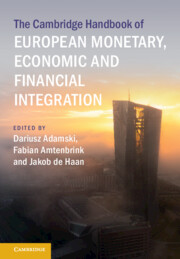Book contents
- The Cambridge Handbook of European Monetary, Economic and Financial Integration
- The Cambridge Handbook of European Monetary, Economic and Financial Integration
- Copyright page
- Contents
- Contributors
- Introduction
- Part I The Economic and Monetary Union
- Part II The Monetary Dimension
- Part III The Economic and Fiscal Dimensions
- Part IV Financial Integration
- 23 Banking Regulation in Europe
- 24 The Politics behind the Creation of the Banking Union
- 25 Failing Banks within the Banking Union at the Crossroads
- 26 The Banking Union
- 27 The Re-emergence of Market-Based Finance?
- 28 The European Strategy on Digital Finance and Its Interplay with Capital Markets Integration in the EU
- 29 Regulating Crypto and Cyberware in the EU
- Index
- References
23 - Banking Regulation in Europe
From Reaction to Thinking Ahead
from Part IV - Financial Integration
Published online by Cambridge University Press: 28 September 2023
- The Cambridge Handbook of European Monetary, Economic and Financial Integration
- The Cambridge Handbook of European Monetary, Economic and Financial Integration
- Copyright page
- Contents
- Contributors
- Introduction
- Part I The Economic and Monetary Union
- Part II The Monetary Dimension
- Part III The Economic and Fiscal Dimensions
- Part IV Financial Integration
- 23 Banking Regulation in Europe
- 24 The Politics behind the Creation of the Banking Union
- 25 Failing Banks within the Banking Union at the Crossroads
- 26 The Banking Union
- 27 The Re-emergence of Market-Based Finance?
- 28 The European Strategy on Digital Finance and Its Interplay with Capital Markets Integration in the EU
- 29 Regulating Crypto and Cyberware in the EU
- Index
- References
Summary
This chapter explores the evolution of banking regulation in Europe, underlining the shift in regulatory trends, from a reactive approach to a more forward-looking one. Originally, banking law reforms constituted immediate reactions to regulatory flaws and omissions revealed by each respective financial downturn. The Great Depression exposed the need to introduce deposit insurance, along with the first capital requirements. The Global Financial Crisis drew regulatory attention to systemic risk, and so an array of legal solutions was adopted with the aim of mitigating it. Recently, this tendency has been changing. Regulators take more proactive steps. This became apparent in the context of the COVID-19 pandemic, when many of their actions were tailored to prevent a banking crisis from materializing. Similarly, with regard to climate risk, both adopted and proposed solutions are highly future-oriented. In the light of digital innovation in banking, regulators choose to act pre-emptively. This is especially visible in their quest to regulate relations between cloud providers and banks.
- Type
- Chapter
- Information
- Publisher: Cambridge University PressPrint publication year: 2023



